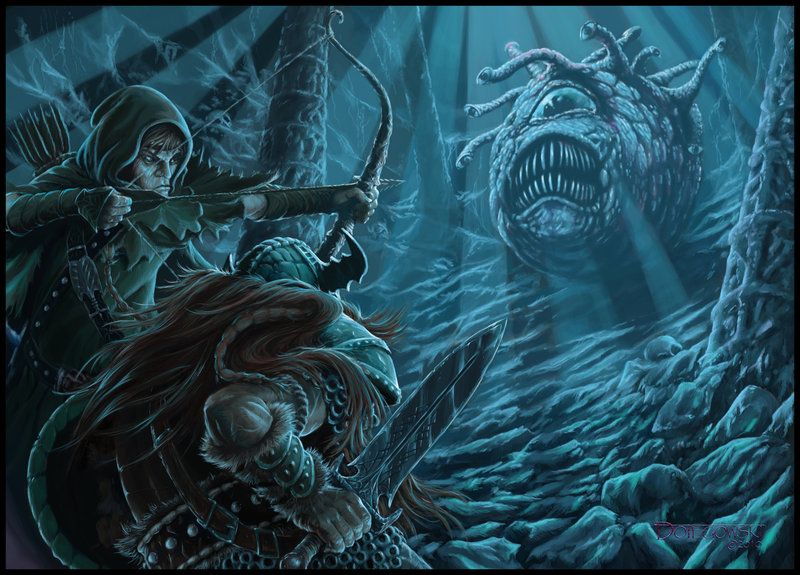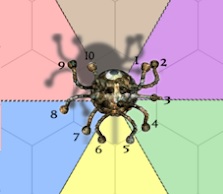Difference between revisions of "Beholder"
Tao alexis (talk | contribs) |
Tao alexis (talk | contribs) |
||
| Line 34: | Line 34: | ||
== Advantages == | == Advantages == | ||
| − | A beholder is able to accomplish a whirlwind of attacks with its eleven eyes — a great eye upon the main orb of its body and ten additional eyes attached by stalks to the top of the creature's head. The great eye is able to see in a 180° arc. | + | [[File:Beholder Fields of Attack.jpg|385px|right|thumb]] |
| + | A beholder is able to accomplish a whirlwind of attacks with its eleven eyes — a great eye upon the main orb of its body and ten additional eyes attached by stalks to the top of the creature's head. The beholder's great eye is its main oracle, denoting the front of the beast; it bulges outwards from the body and is able to see in a 180° arc. On the image shown, this enables the beholder to attack opponents in the orange, brown and purple areas, including creatures standing on the boundaries of those zones. | ||
| − | + | {| class="wikitable" style="float:left; margin-right: 25px; text-align: center; background-color:#d4f2f2;" | |
| + | |+Choices | ||
| + | ! style="width: 55px|Stalks !! style="width: 140px"|Situation | ||
| + | |- | ||
| + | | one & two || | ||
| + | The stalks upon the beholder's head are only partially flexible, so each can only attack a 120° arc and no better. The table indicates which stalks can attack which coloured areas surrounding the beholder. | ||
| − | |||
| − | + | ||
| + | that they can each attack only a Stalk numbers 1 and 2 can attack the brown and purple zones (borders always included). Stalk number 3 can attack the purple and green zones. Stalks 4 and 5 can attack the green and yellow zones. Stalks 6 and 7 and attack the yellow and blue zones. Stalk number 8 can attack the blue and pink zones. And finally, stalks number 9 and 10 can attack the pink and brown zones. | ||
Each stalk shown in the figure has a different power, as follows: stalk 1 (disintegrate), stalk 2 (telekinesis), stalk 3 (sleep), stalk 4 (hypnotism), stalk 5 (fear), stalk 6 (slow), stalk 7 (hold person or monster), stalk 8 (flesh-to-stone), stalk 9 (cause wound), stalk 10 (death). Finally, the great eye (no. 11) can produce an anti-magic ray. The description of these special powers is outlined as follows, numbers corresponding to the eye that can use that power. Each eye can be used once per round. | Each stalk shown in the figure has a different power, as follows: stalk 1 (disintegrate), stalk 2 (telekinesis), stalk 3 (sleep), stalk 4 (hypnotism), stalk 5 (fear), stalk 6 (slow), stalk 7 (hold person or monster), stalk 8 (flesh-to-stone), stalk 9 (cause wound), stalk 10 (death). Finally, the great eye (no. 11) can produce an anti-magic ray. The description of these special powers is outlined as follows, numbers corresponding to the eye that can use that power. Each eye can be used once per round. | ||
Revision as of 21:36, 22 May 2022
| Species | beast |
| No. Appearing | 1 |
| Behaviour | malevolent |
| Range | subterranean |
| Size | 4 to 6 ft. in diameter |
| Weight | 550 lbs. |
| Intelligence | 15 |
| Armour Class | 0 |
| Hit Dice | 15 |
| Action Points | 1 |
| Max. Stride | {{{stride}}} |
| THAC0 | 12 |
| Hp/Die | d10 |
| Attack Forms | 1: maw (attack) |
| Damage | maw [3–24] |
| Special Attacks | anti-magic, cause wound, death, disintegrate, fear, hold person or monster, hypnotism, levitation, petrification, sleep, slow, telekinesis |
The beholder, or eye-tyrant, is well-known as one of the deadliest creatures to exist anywhere. It's only been encountered at the core of deep dungeons, preferring to make its lair in a small cave. The size is chosen to ensure the beholder room enough to unleash its infamous arsenal of magical attacks, while the line-of-sight keeps interlopers in range of the beast's powers.
Lair
Typically, the beholder is supported by upper levels of lesser creatures, helplessly in the beholder's thrall. While allowed to dwell and live out their lives, these slave creatures are organized so as to protect the beholder's lair and give warning to the beast if anyone should attempt to fight their way down through the complex warrens above. These slaves also feed the beholder, sometimes with their own bodies. A beholder's appetite is prodigious.
In reality, the beholder is notably vulnerable. Despite its powers, if enough creatures were to give their lives in a rush against it's attacks, the beholder could be overwhelmed. Though many would die, the remainder — with oil and torches — could set the beholder's lair alight. Another means might to be seal the beholder in its own lair, or somehow bring about an avalanche. Even if it survived, the beholder would be forced to look for its own food. This might enable a group of adventurers, or even a large beast to take it by surprise and bring about it's end.
The beholder's greatest power is its intelligence: knowing precisely how to make its lair safe and cultivate its minions, so that they're either too frightened or too dependent to turn on their master.
Description
The beholder is shaped like a globe, covered in heavy plating and hardened ridges, causing its surface to appear stone-like. The beholder has eleven eyes altogether. It has a large mouth and one great eye that identifies the front of the sphere. Atop the sphere are ten stalks, each of which is topped with a much smaller eye.
Each of these eyes are blessed with a unique and individual power, any of which may be employed by the beholder once per round (see below). These eyes are grouped on the beholder's head in a particular fashion; none of these eyes has the power to affect a 360° circle around the beholder. This means, depending on how the beholder chooses to orient itself, or upon which side it is approached, some of the eyes can be brought to bear on the target and some not.
Advantages
A beholder is able to accomplish a whirlwind of attacks with its eleven eyes — a great eye upon the main orb of its body and ten additional eyes attached by stalks to the top of the creature's head. The beholder's great eye is its main oracle, denoting the front of the beast; it bulges outwards from the body and is able to see in a 180° arc. On the image shown, this enables the beholder to attack opponents in the orange, brown and purple areas, including creatures standing on the boundaries of those zones.
| Stalks | Situation |
|---|---|
| one & two |
The stalks upon the beholder's head are only partially flexible, so each can only attack a 120° arc and no better. The table indicates which stalks can attack which coloured areas surrounding the beholder.
Each stalk shown in the figure has a different power, as follows: stalk 1 (disintegrate), stalk 2 (telekinesis), stalk 3 (sleep), stalk 4 (hypnotism), stalk 5 (fear), stalk 6 (slow), stalk 7 (hold person or monster), stalk 8 (flesh-to-stone), stalk 9 (cause wound), stalk 10 (death). Finally, the great eye (no. 11) can produce an anti-magic ray. The description of these special powers is outlined as follows, numbers corresponding to the eye that can use that power. Each eye can be used once per round.
Engaging a Beholder in CombatObviously, because of the Beholder's formidable power, defenders will be anxious to find strategies to counteract the many eye attacks or at least fool the Beholder into wasting its powers on lesser combatants. As well, knowing which attacks can affect which arcs around the beholder can be useful, if protection spells of various sorts can be obtained. Most will be anxious to destroy eyes, in order to reduce the beholder's potential for destruction, if only to weaken the creature before a retreat is called, so that another engagement can be arranged by the survivors. It is possible to destroy all of the beholder's eyes except for the great eye, which will survive so long as the beholder's body remains intact. To destroy the great eye, the beholder must be reduced in hit points to -10 (it counts as a leveled creature). To destroy an eyestalk, however, is easier. It can be struck with a weapon, swung, thrown or fired, so long as AC -5 is successfully hit. The beholder will usually levitate high enough above the floor to preclude direct melee and may save its telekinesis power for the initial salvo, that will tend to take place as a party rushes in. Of course, a beholder may be surprised by someone that is invisible, under the effect of a sanctuary spell or using various magic items for the purpose of deception, enabling a lucky shot that could take out the death or disintegration eyes (or whichever seems best). However, it should not be supposed that the beholder will be alone, or that its lair will have a conveniently flat floor or that there won't be traps set by its minions designed to reveal hidden interlopers. The beholder is of genius intelligence and will be prepared for most simple tactics; would-be attackers should be warned. As well, it should be understood that there are two species of beholder. The above describes the "left-handed" beholder. In the "right-handed" beholder, the eyes are located in a mirrored position to that which appears in the diagram (left is right and right is left). It requires a true expert of beholders to visually tell the difference.
|

